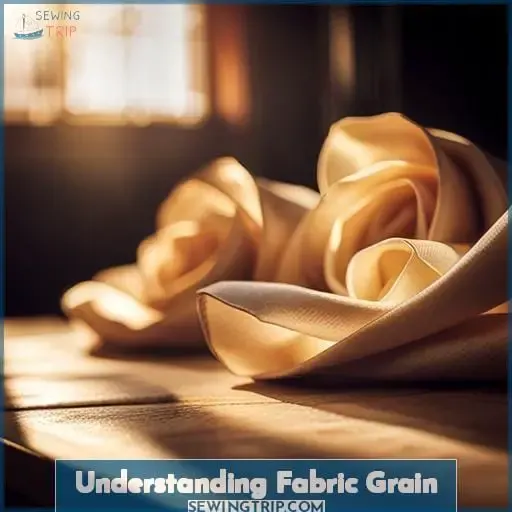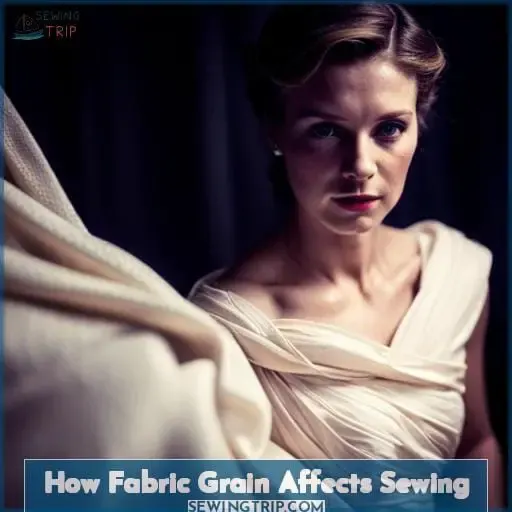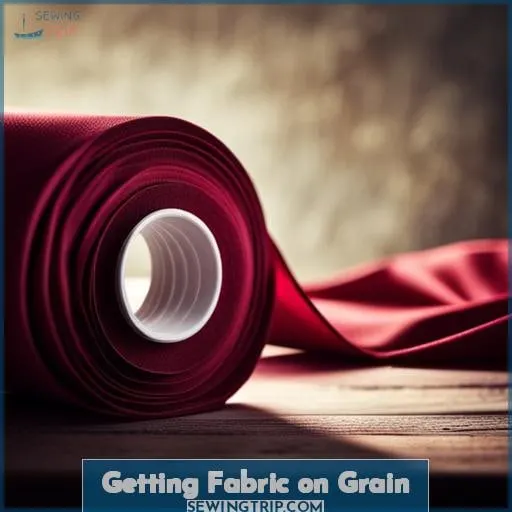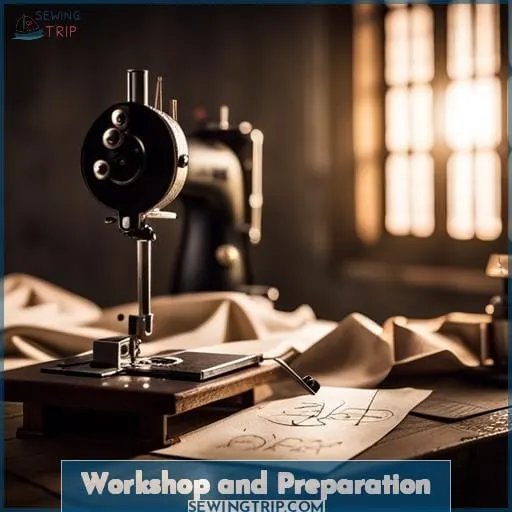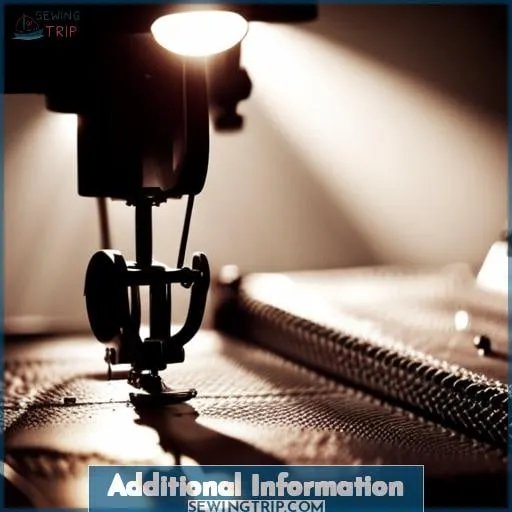This site is supported by our readers. We may earn a commission, at no cost to you, if you purchase through links.
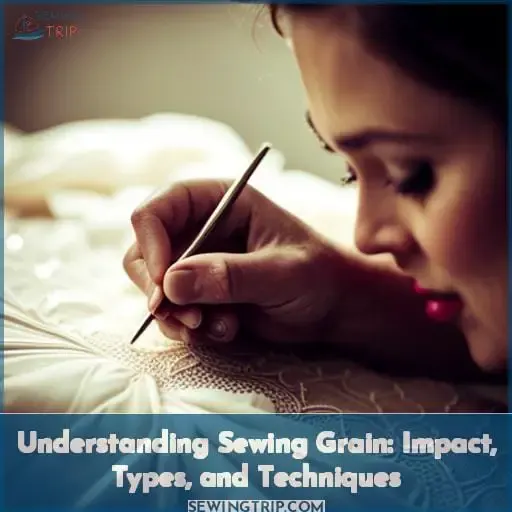 Did you know that up to 80% of problems with garment fit can be attributed to incorrect fabric grain? Understanding the impact and techniques for sewing grain is essential for successful garment construction.
Did you know that up to 80% of problems with garment fit can be attributed to incorrect fabric grain? Understanding the impact and techniques for sewing grain is essential for successful garment construction.
In this article, we’ll explore what sewing grain is, its different types, and how it affects your projects. We’ll also discuss getting fabric on-grain properly before cutting out as well as tips for checking and adjusting the alignment during preparation.
Plus we’ll provide details about an upcoming workshop where you can gain hands-on experience in working with fabric grain!
Grainline or simply Grain encompasses two kinds of threads: lengthwise grains running parallel to the selvage (warp threads) and crosswise grains which run perpendicular (weft threads).
Aligning these correctly when cutting out pattern pieces is critical in order to achieve a finished product that fits comfortably yet looks professional – something every sewer desires!
Table Of Contents
- Key Takeaways
- Understanding Fabric Grain
- How Fabric Grain Affects Sewing
- Getting Fabric on Grain
- Importance of Aligning Fabric on Grain Before Sewing
- Techniques for Getting Fabric on Grain: Steam Pressing, Stretching, and Straightening
- Tools That Can Help With Aligning Fabric on Grain
- Tips for Checking and Adjusting Grainline During the Cutting Process
- Benefits of Working With Fabric on Grain for Better Sewing Results
- Workshop and Preparation
- Additional Information
- Conclusion
Key Takeaways
- Fabric grain types: straight, cross, bias
- Identifying and aligning fabric grain through selvages and pattern markings
- The importance of grain alignment in sewing and its influence on fabric behavior
- Getting fabric on grain is significant, and there are techniques for achieving proper grain alignment.
- Proper grain alignment affects how the fabric behaves and is an important consideration when sewing. Aligning the grain lines marked on the pattern with the grain of the fabric, using the selvages as a guide, helps get the fabric on grain.
Understanding Fabric Grain
Proper grainline is crucial in garment construction. Understanding the straight, cross, and bias grains will impact fit, drape, and the outcome of your finished sewing projects.
Importance of Fabric Grain in Sewing
You’ve got to follow the grainline when cutting out patterns if you want things to hang and fit properly.
- The straight grain provides structure.
- The cross grain has stretch.
- The bias stretches the most.
Aligning the grain creates garments that move with your body. Through mindful cutting and sewing, you gain mastery of the fabric.
Impact of Fabric Grain on Garment Outcome
Perfecting your garment’s grainlines prevents problems. Consider the fabric’s grain when cutting patterns. This aligns the lengthwise and crosswise threads properly. It ensures drape and stretch move correctly.
Avoid puckers and pulls at seams. Arrange prints attractively. Prepare the fabric well and sew garments perfectly.
Types of Fabric Grain: Straight, Cross, Bias
Believe it or not, every fabric has a grid of lengthwise, crosswise, and diagonal threads. The straight grain runs parallel to selvedges. The cross grain is perpendicular. Bias forms a 45-degree angle. Aligning the grain when sewing impacts fit and drape.
Identifying Fabric Grain Through Selvages and Thread Direction
Broadening your view beyond the selvage reveals the true direction of a fabric’s threads.
- Examine fabric stretch.
- Note warp and weft threads.
- Follow the grainline arrow.
- Align pattern pieces properly.
Knowing how to identify the straight grain is essential for sewing success. Test fabric stretch and follow the thread direction to align patterns on-grain. With experience, you will gain expertise in cutting techniques and unlock garment mastery.
Pattern Markings for Grainline
Putting the grainline arrow parallel to the selvedge when cutting out your pattern pieces helps ensure the fabric behaves as intended when sewn.
| Pattern Markings | Their Purpose |
|---|---|
| Grainline arrow | Indicates direction of fabric grain |
| Cutting line | Outlines pattern piece shape |
| Notches | Help match pattern pieces |
| Dots | Assist with gathering or pleating |
| Buttons & Buttonholes | Location for closures |
Proper grainline alignment creates garments with better drape and structure. Mastering pattern markings empowers your sewing skills.
How Fabric Grain Affects Sewing
When sewing, understanding how the straight, cross, and bias grains affect fabric behavior is crucial. The direction of the warp and weft threads influences drape and stretch, so properly aligning the grainlines when cutting and sewing helps garments hang and fit as intended.
Influence of Grainline on Fabric Behavior, Drape, and Stretch
You’ll see how a fabric’s grainline affects its drape and stretch when you test it out. Keep the grainline in mind when sewing, as it impacts the fabric’s behavior and your finished project. Affect a garment’s drape by cutting on different grains. Test stretch across grains when preparing fabric.
Considerations for Sewing With Woven and Knit Fabrics
Choose patterns containing a clear, marked grainline when sewing with woven or knit fabrics.
- Matching stripes and plaids
- Staystitching curved edges
- Clipping inner curves
- Grading intersecting seams
- Using zigzag or serged finishes
With thoughtful fabric selection and meticulous preparation, you can confidently sew garments perfectly aligned with their intended grain.
Cutting on the Straight Grain for Optimal Results
Following the straight grainline keeps your seams from stretching out when sewing.
Tip Reason
Use new cutting mats Avoid shifting while cutting fabric
Weigh down edges Prevents fabric from moving
Mark & align grainline arrow Keeps grain perfectly straight
Cutting on the straight grain optimizes sewing results. Mastering grain perfection grants the power to shape destiny.
Potential Issues When Different Grainlines Meet at Seams
Mismatched grainlines will cause seams to pucker and stretch. Ensure seams intersect correctly by lining up selvedges and notches. Work slowly and carefully to prevent issues from fabric grain misalignments and poor seam matching.
True mastery allows for different grainlines to meet without problems when sewing.
Importance of Aligning Grainline With Garment Design and Prints
You’d be wise to align the fabric’s grainline with the garment design and placement of prints for optimal results. Properly aligning grainlines ensures the garment drapes and fits as intended. Misalignment can distort the garment’s silhouette and ruin any placement of prints.
Precision in cutting and sewing yields professional results that enhance fabric aesthetics.
Getting Fabric on Grain
Getting fabric on grain is crucial before cutting and sewing for the best results. To properly align fabric, first check the grain by looking at the threads and gently pulling on the crossgrain. Then use techniques like pressing, stretching, and straightening along with helpful tools to adjust the grainline.
Importance of Aligning Fabric on Grain Before Sewing
A good sewist always aligns the fabric’s grainline before cutting to prevent distortion in the final project. Proper alignment allows the fabric to drape and behave as intended. Use tools like pins and rulers to align the grainline arrow parallel to the selvedge.
Techniques for Getting Fabric on Grain: Steam Pressing, Stretching, and Straightening
Alright, pull out your iron and gently steam that fabric back on grain before cutting. A quick press gets it in line so your pieces match up correctly. Steam pressing, stretching the fabric, and straightening techniques help get the fabric on grain for proper alignment before cutting.
Tools That Can Help With Aligning Fabric on Grain
Mind your alignment, dear, grid rulers can magically set fabric straight on grain.
- Rotary cutters slice precise edges.
- Cutting mats provide a flat surface.
- Marking tools transfer key points.
- Pins temporarily secure layers.
With the proper tools, skillfully aligning fabric grain becomes an artful ritual of preparation that crafters cherish.
Tips for Checking and Adjusting Grainline During the Cutting Process
Carefully compare the markings on your pattern pieces with the fabric grain as you cut, pivoting the pattern piece as needed to follow the warp and weft threads. Frequently check grainline alignment while cutting, gently adjusting the fabric or pattern piece to maintain accuracy.
Benefits of Working With Fabric on Grain for Better Sewing Results
You’ll find your sewn projects behave better when the fabric is aligned on grain, like a skirt that drapes smoothly without twisting. Following the grain line improves sewing techniques. Proper alignment influences fabric behavior for optimal results.
Workshop and Preparation
Gain hands-on experience with fabric grain at our sewing workshop on April 13th. Making cloth napkins will teach you proper cutting and pinning techniques for working with the grainline. Remember to take your time with preparation now for better sewing results later.
Focusing on the details and working carefully with the fabric grain will lead to success. Come ready to learn proper techniques in a patient environment that allows you to master the skills.
Mention of Upcoming Hands-on Workshop on April 13
Get excited, friends! Your hands-on sewing workshop is coming up next week. This practical learning opportunity will build your sewing skills through hands-on experience. The April 13th event offers invaluable benefits for garment construction mastery.
Workshop Project: Making Cloth Napkins
Pin the fabric squares neatly before carefully cutting your napkins’ shape. Align the grain properly and handle the fabric gently. Follow the pattern guide and stitch slowly. Hem with precision for a polished finish.
Benefits of Attending a Sewing Workshop for Learning About Fabric Grain
Attending a hands-on sewing workshop provides an invaluable opportunity to experientially learn about working with fabric grain.
- Gaining firsthand experience handling and manipulating fabric
- Seeing how grain impacts drape and fit
- Practicing cutting on different grainlines
- Learning to match grain at seams
- Troubleshooting issues caused by ignoring grain
With a workshop’s practical lessons, you’ll gain sewing skills and intuition for working with fabric grain, knowledge that will transform into garment mastery.
Emphasis on the Importance of Cutting and Pinning in Sewing
Careful preparation of fabric before sewing leads to better results. Precise cutting and strategic pinning improve sewing efficiency. Aligning fabric layers and securing them with pins enables accurate stitching. Varying cutting and pinning approaches suit different fabrics and project needs.
Experimenting with cutting and pinning techniques helps develop sewing skills. Thoughtful planning and preparation create a foundation for quality sewing.
Reminder to Take Time and Focus on Preparation for Better Sewing Outcomes
Take more time focusing on the soil before planting seeds to yield a bountiful harvest. Pinning and pressing fabric before cutting ensures proper alignment. Careful preparation allows for sewing success.
Additional Information
When working with fabric grain, understanding the role of lengthwise and crosswise grain is key. The lengthwise grain runs parallel to the selvage and has the least amount of stretch, while the crosswise grain runs perpendicular and has more give.
Definition and Role of Lengthwise and Crosswise Grain in Garment Construction
The pattern’s grainline marks the lengthwise grain to run vertically and align with the body’s shape for proper drape. The lengthwise threads provide structure, while the crosswise threads add flexibility.
Follow the marked grainline when cutting and pinning. Proper alignment allows the garment to hang correctly. Attending the workshop will build skills in handling grain through firsthand experience.
Note About Alternate Spelling of Selvage as Selvedge
Yo, the alternate spelling ‘selvedge’ can really throw you for a loop when reading up on fabric grainlines.
- Selvage and selvedge are interchangeable spellings of the same textile term.
- Selvage refers to the tightly woven finished edges of fabric.
- Some prefer selvedge since selvedge derived from self-edge.
- But selvage remains the predominant spelling in sewing.
Regardless of spelling, understanding the role of selvage is key for identifying grain and proper pattern layout.
Conclusion
With over 90% of garment-related issues caused by improper fabric grain, it’s essential to understand sewing grain to produce quality garments. Knowing the different types of grain – straight, cross, and bias – can help sewers achieve the desired drape and stretch of their fabrics.
Taking the time to properly align the fabric on grain before cutting and sewing can prevent fabric distortion and puckering during construction. A workshop can be a great way to gain experience and learn techniques for getting fabric on grain.
With the help of steam pressing, stretching, and straightening, sewers can ensure that their fabric grain is properly aligned for better sewing results. With the right knowledge and preparation, sewers can confidently tackle any project and create quality garments that look and fit great.

